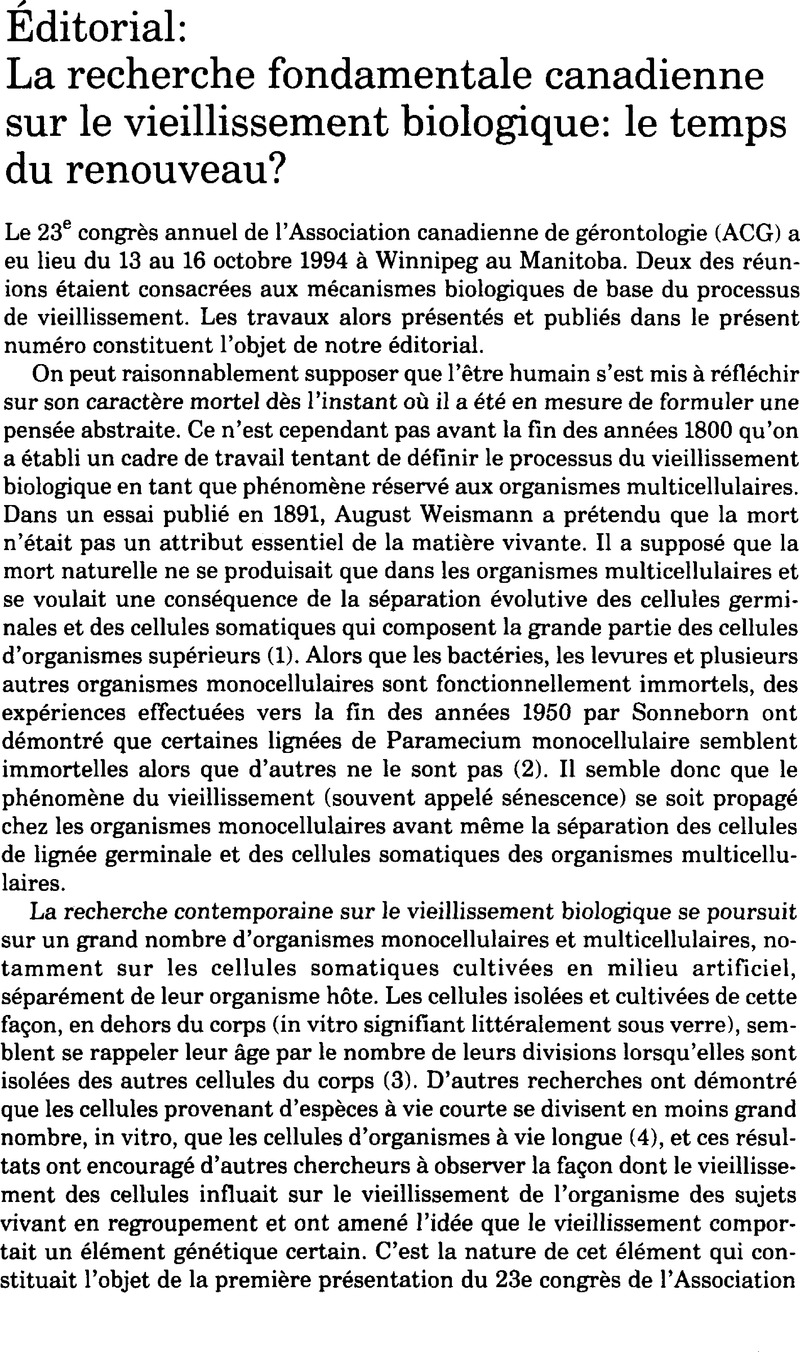No CrossRef data available.
Article contents
Éditorial: La recherche fondamentale canadienne sur le vieillissement biologique: le temps du renouveau?
Published online by Cambridge University Press: 29 November 2010
Abstract
An abstract is not available for this content so a preview has been provided. As you have access to this content, a full PDF is available via the ‘Save PDF’ action button.

- Type
- Editorial/Éditorial
- Information
- Canadian Journal on Aging / La Revue canadienne du vieillissement , Volume 15 , Issue 1 , Spring/printemps 1996 , pp. 5 - 9
- Copyright
- Copyright © Canadian Association on Gerontology 1996
References
Références
1.Weismann, A.Essays upon heredity and kindred biological problems. London and New York: Oxford Univ. Press (Clarendon), 1891.Google Scholar
2.Sonneborn, TM, Rofolko, M. Aging in the P. aureita-multimicronucleatum complex. J. Protozool 1957; 4: 21.Google Scholar
3.Hayflick, L. The limited in vitro lifespan of human diploid cell strains. Exp. Cell Res. 1965; 37: 614.CrossRefGoogle Scholar
4.Martin, GM, Sprague, CA, Epstein, CJ. Replicative life-span of cultivated human cells: Effects of donor's age, tissue and genotype. Lab. Invest. 1970: 23: 86.Google ScholarPubMed
6.Enesco, HE. Genetic control of the aging process: a review and interpretation. Can J. Aging 1996, this issue.CrossRefGoogle Scholar
8.Seshadri, T, Campisi, J. Repression of c-fos transcription and an altered genetic program in senescent human fibroblasts. Science 1990; 247: 205.Google Scholar
9.Riabowol, K, Schiff, J, Gilman, MZ. Transcription factor AP-1 activity is required for initiation of DNA synthesis and is lost during cellular aging. Proc. Natl. Acad. Sci. USA. 1992; 89: 157.CrossRefGoogle ScholarPubMed
10.Atadja, PW, Stringer, KS, Riabowol, KT. Loss of serum response element-binding activity and hyperphosphorylation of serum factor during cellular aging. Mol. Cell Biol. 1994; 14: 4991.Google Scholar
12.Strehler, BL. Origin and comparison of the effects of time and high energy radiations on living systems. Quart. Rev. Biol. 1959; 34: 117.CrossRefGoogle ScholarPubMed
13.Orr, WC, Sohal, RS. Extension of lifespan by overexpression of Superoxide dismutase and catalase in Drosophila melanogaster. Science 1994; 263: 1128.Google Scholar
14.Wang, E. Senescent human fibroblasts resist programmed cell death, and failure to suppress bcl2 is involved. Cancer Research 1995; 55: 2285.Google Scholar
15.Dubina, TL. Biological age as a tool for the determination of the rate of aging. In: Balin, AK, éd. Practical handbook of human biologic age determination. Boca Raton, London, Tokyo, Ann Arbor: CRC Press, 1994.Google Scholar
16.Adams, P, Davies, GT, Sweetnam, P. Osteoporosis and the effects of aging on bone mass in elderly men and women. Q. J. Medicine 1970; 39: 601.Google Scholar
17.Strehler, BL. Time, cells and aging. 2e éd. New York, San Francisco, London: Academic Press, 1977.Google Scholar
18.Palc, J, Anderson, A.Science in Canada: underinvestment lies at the core. Nature 1988; 333: 719.Google Scholar




